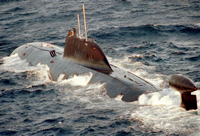The American defense community has properly reacted with nonchalance to the appearance of two Russian nuclear-powered submarines off the U.S. East Coast. Neither the submarines nor the rest of the Russian Navy presently represent a major threat to the United States.
In a formal statement, the U.S. Northern Command confirmed the subs' unusual presence, but pointed out they remained outside U.S. territorial waters and engaged in legally permissible transit and other non-threatening activities. Pentagon spokesman Geoff Morrell later explained that, "So long as they are operating in international waters, as, frankly, we do around the world, and are behaving in a responsible way, they are certainly free to do so, and it doesn't cause any alarm within this building." The U.S. Navy regularly conducts similar patrols throughout the globe and insists on its right to freedom of navigation in international waters.
Anatoly Nogovitsyn, deputy chief of staff of the Russian armed forces, also downplayed the submarines' presence by describing them as simple maritime training operations. Nogovitsyn compared them with the global air patrols Russia's strategic bombers resumed two years ago, which he argued were natural activities for a major military power like Russia that had improved the country's strategic aviation capacity. Nogovitsyn and other Russian officials disputed the assertions of U.S. analysts that the patrols marked the first combat deployment in the Western Hemisphere in over a decade. They claim that the submarines had never completely ended such patrols even if their number had diminished after the end of the Cold War.

